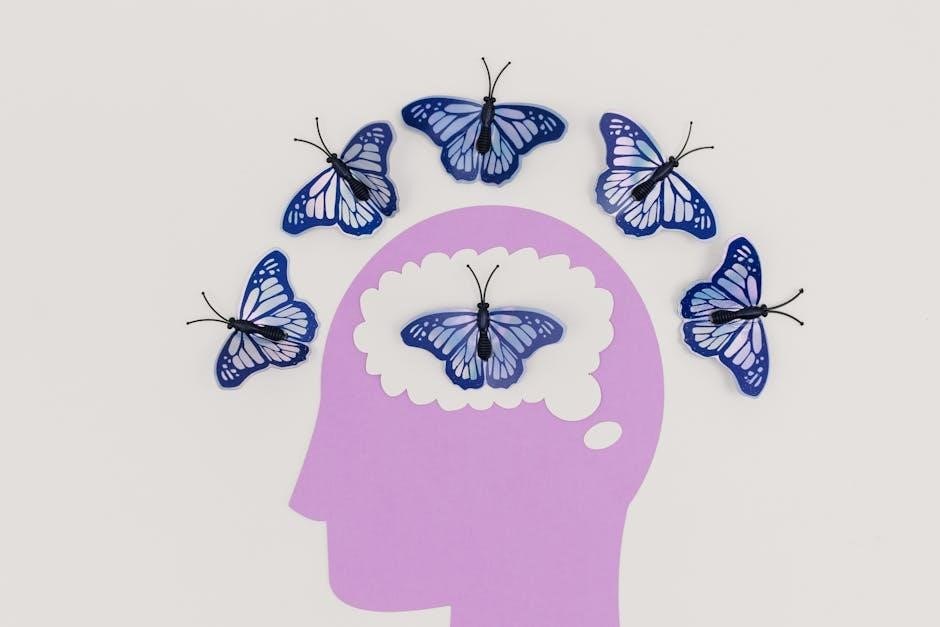The brain is divided into four functional lobes: frontal, parietal, temporal, and occipital. Each lobe specializes in specific functions, enabling complex processes like cognition, sensation, and motor control.
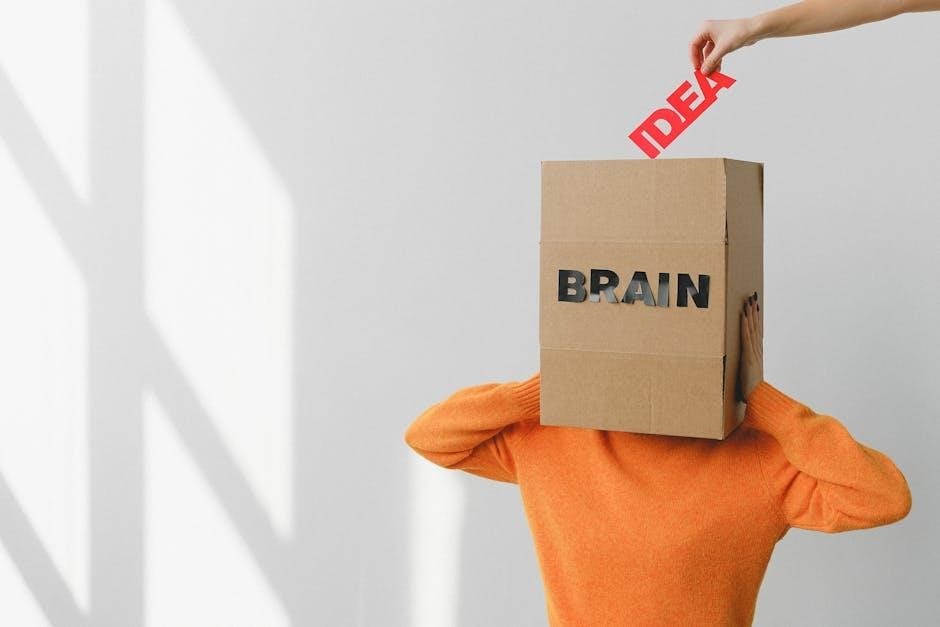
Frontal Lobe
The frontal lobe, located in the brain’s front, manages planning, organizing, problem-solving, and attention. It also influences personality and decision-making, with the prefrontal cortex playing a key role.
2.1 Functions and Role
The frontal lobe is crucial for executive functions, including planning, decision-making, and problem-solving. It governs motor control, enabling voluntary movements and coordination. This lobe also regulates personality, impulse control, and social behavior, making it essential for cognitive and emotional processes. Its role extends to attention and focus, allowing individuals to prioritize tasks and manage complex mental operations. Damage to this area can impair judgment, planning, and motor skills, highlighting its significance in maintaining normal brain function and overall behavior.
2.2 Notable Areas (e.g., Prefrontal Cortex)
The prefrontal cortex is a key area within the frontal lobe, responsible for advanced cognitive functions like planning, organizing, and decision-making. It plays a vital role in personality development and social behavior, enabling complex thought and impulse control. This region is also associated with working memory and attention, crucial for processing information and focusing on tasks; Additionally, Broca’s Area, located in the frontal lobe, is essential for speech production and language processing. These areas highlight the frontal lobe’s importance in higher-order thinking and communication, making it a central hub for human cognition and behavior.
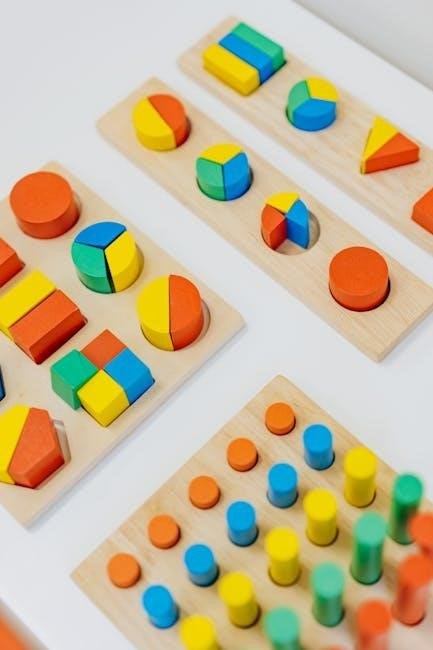
Parietal Lobe
The parietal lobe processes sensory information, aiding spatial awareness, navigation, and tactile perception. It integrates sensory data to help understand the environment and guide physical movements effectively.
3.1 Functions and Role
The parietal lobe plays a crucial role in processing sensory information, particularly related to touch, spatial awareness, and navigation. It helps integrate sensory data from the body, enabling the brain to understand physical sensations like pain, temperature, and pressure. This lobe is also involved in spatial orientation, assisting in tasks that require understanding the position and movement of objects or oneself in space. Additionally, it contributes to mathematical reasoning and language processing, highlighting its importance in cognitive functions beyond basic sensory input. Damage to this area can impair spatial perception and the ability to interpret sensory information effectively.
3.2 Notable Areas
The parietal lobe contains several notable areas that contribute to its sensory and cognitive functions. The somatosensory cortex, located in the postcentral gyrus, is responsible for processing touch, pain, and temperature sensations from the body. Another key region is the intraparietal sulcus, which plays a role in spatial awareness, attention, and mathematical reasoning. These areas work together to integrate sensory information, enabling tasks like navigating environments and understanding spatial relationships. Damage to these regions can lead to impairments in sensory perception and spatial cognition, highlighting their critical importance in everyday functioning.
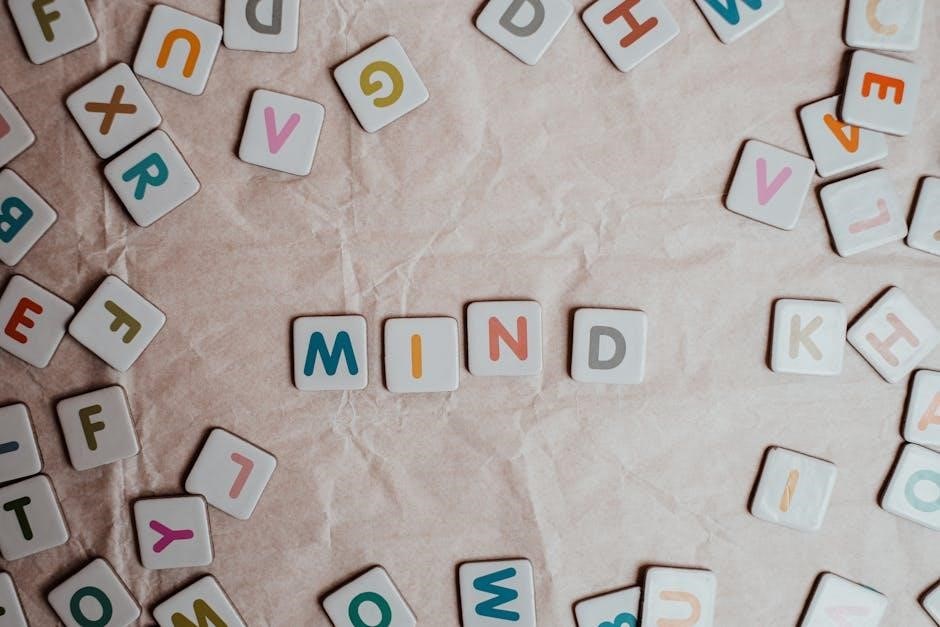
Temporal Lobe
The temporal lobe, located on the brain’s lateral surface, plays a crucial role in auditory processing, memory, and language. It houses the hippocampus, essential for memory formation.
4.1 Functions and Role
The temporal lobe is essential for processing auditory information, enabling sound recognition and speech comprehension. It plays a critical role in memory formation, particularly the conversion of short-term memories into long-term ones. The hippocampus, located within the temporal lobe, is vital for spatial navigation and autobiographical memory. Additionally, this lobe is involved in language processing, with areas like Wernicke’s area contributing to understanding spoken language. It also processes sensory information, integrating sights, sounds, and emotions to interpret environmental stimuli. Damage to the temporal lobe can impair auditory perception, memory, and language abilities, highlighting its significance in cognitive and sensory functions.
4.2 Notable Areas (e.g., Hippocampus)
The temporal lobe contains several notable areas critical for brain function. The hippocampus, a structure within the temporal lobe, is essential for memory formation, particularly spatial and autobiographical memory. It plays a key role in converting short-term memories into long-term ones. Another significant area is Wernicke’s area, which is vital for language comprehension and processing spoken language. Damage to these areas can lead to severe memory impairments, such as difficulty forming new memories, and language deficits. The hippocampus is also involved in spatial navigation, making it crucial for understanding one’s environment. These areas highlight the temporal lobe’s importance in memory, language, and sensory processing.

Occipital Lobe
The occipital lobe, located at the brain’s rear, primarily processes visual information, enabling perception and interpretation of sensory data from the eyes.
5.1 Functions and Role
The occipital lobe’s primary function is to process visual information, interpreting signals from the retina to create coherent images. It specializes in recognizing shapes, colors, and movement, crucial for tasks like reading and identifying objects. Damage to this area can lead to vision impairments, such as blindness or difficulty recognizing visual patterns. This lobe also collaborates with other brain regions to integrate visual data with memory and sensory inputs, enhancing overall perception. Its role is vital for understanding and navigating the visual world, making it indispensable for daily activities that rely on sight and visual comprehension;
5.2 Notable Areas
The occipital lobe contains specialized regions dedicated to visual processing. The primary visual cortex, also known as V1, is the first point of processing for visual information from the eyes. Secondary and tertiary visual areas, such as V2, V3, and V4, further refine this information, focusing on aspects like color, form, and motion. Additionally, V5 is linked to motion detection, enabling the perception of movement. These areas work collaboratively to interpret visual data, ensuring accurate and detailed perception. Damage to these regions can impair specific visual functions, highlighting their critical role in processing and interpreting sensory input effectively.
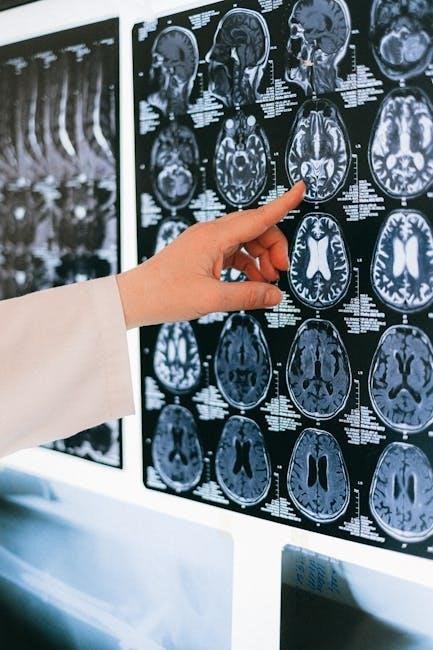
Brain Structure Beyond Lobes
The occipital lobe features distinct regions crucial for visual processing. The primary visual cortex (V1) is the first point of processing for visual information from the eyes. Secondary areas like V2, V3, and V4 specialize in processing color, form, and complex patterns. V5 is associated with motion detection, enabling the perception of movement. These regions work together to interpret visual data, ensuring detailed perception. Damage to these areas can lead to specific visual impairments, such as blindness to motion or color, underscoring their vital role in processing sensory input. Their collaborative function is essential for interpreting and understanding visual stimuli effectively.
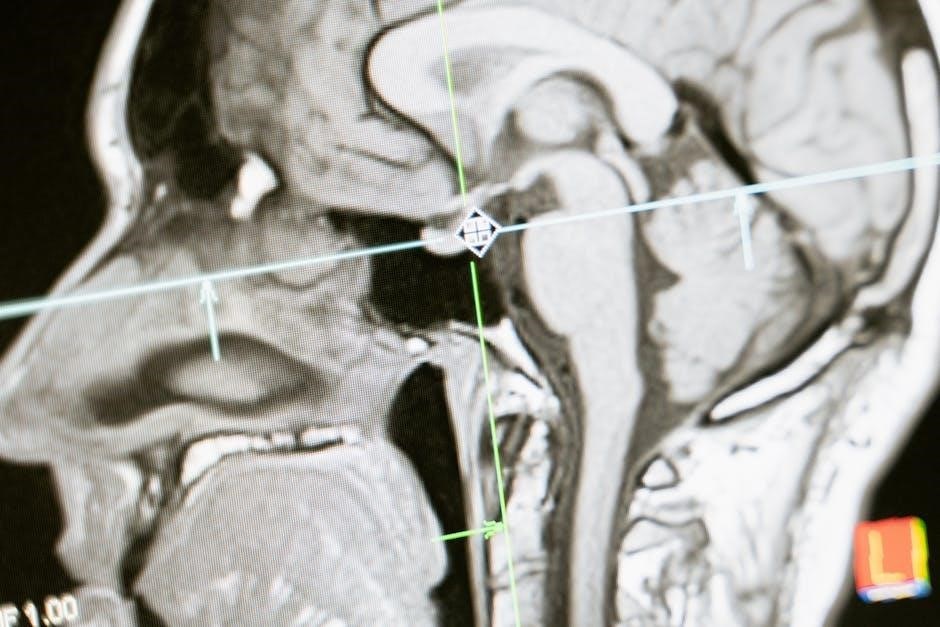
Interconnections Between Lobes
The brain lobes are highly interconnected, enabling seamless communication and coordination. The frontal lobe links with the parietal lobe to process spatial awareness and motor planning, while the temporal lobe connects with the frontal lobe for memory and language tasks. These interconnections allow for integrated brain function, ensuring cohesive thoughts and actions.
The occipital lobe collaborates with the temporal and parietal lobes to interpret visual information, highlighting the brain’s networked structure. Such interconnectivity is vital for complex cognitive processes, demonstrating how lobes work together to enable perception, movement, and higher-order thinking. This integration underscores the brain’s remarkable efficiency in processing information and responding to stimuli.
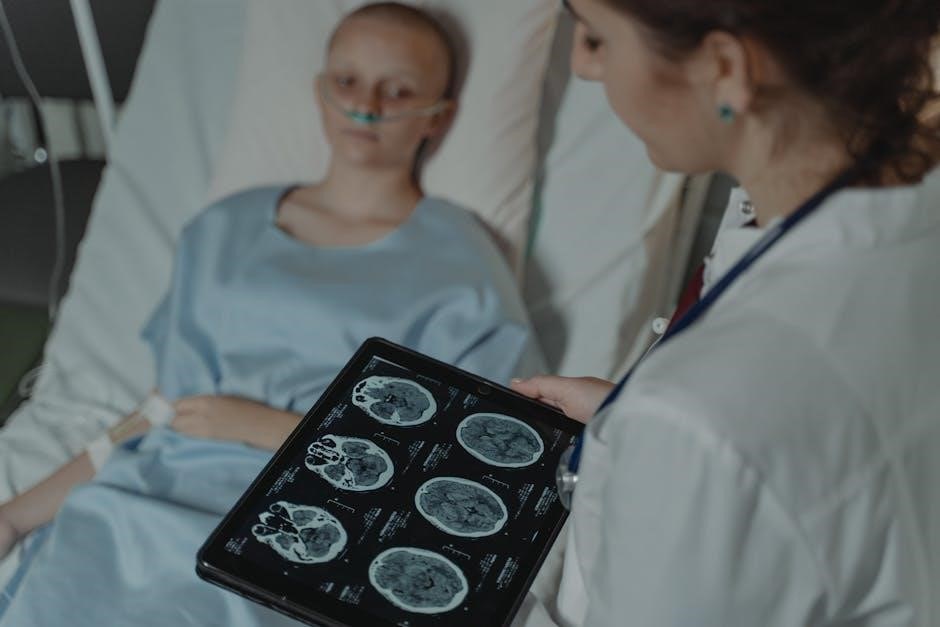
Clinical Significance of Lobes
The clinical significance of brain lobes lies in their specialized roles, which are crucial for diagnosis and treatment of neurological disorders. Damage to specific lobes can lead to distinct deficits, aiding in localization of brain injuries or diseases. For instance, frontal lobe damage often results in impaired decision-making or personality changes, while temporal lobe issues may affect memory or language. Understanding these functional divisions helps clinicians identify abnormalities and develop targeted therapies. Neuroimaging and behavioral assessments rely on lobe-specific functions to pinpoint pathology, emphasizing their importance in modern neuroscience and patient care.
This knowledge also guides rehabilitation strategies, focusing on compensatory mechanisms to address lobe-related deficits, ultimately improving patient outcomes in neurological and psychiatric conditions.
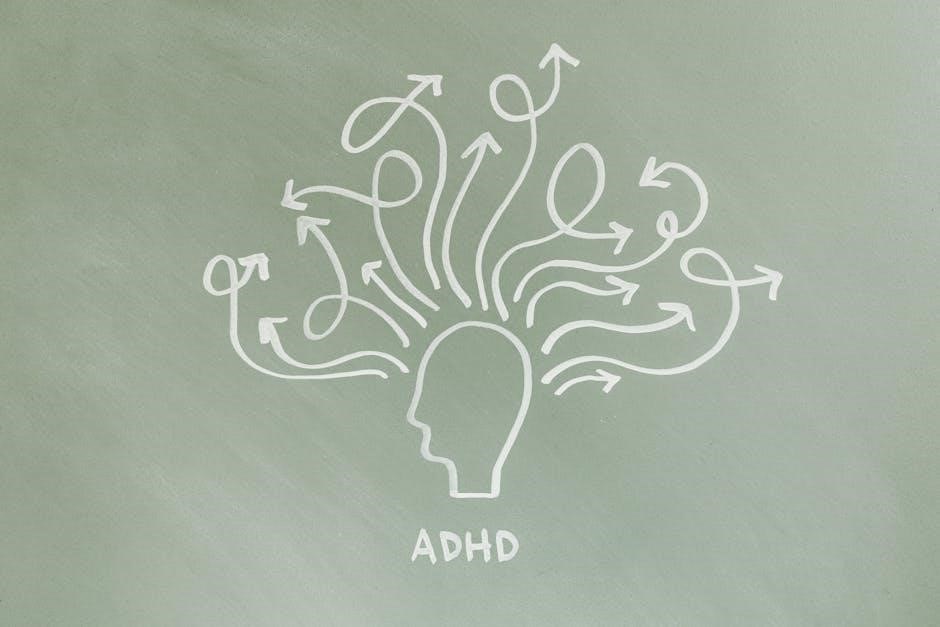
Impact of Damage to Brain Lobes
Damage to brain lobes can result in significant functional deficits, depending on the affected area. For example, frontal lobe damage may impair decision-making, problem-solving, and personality traits, while temporal lobe damage can disrupt memory and language processing. Parietal lobe injuries often affect spatial awareness and sensory integration, and occipital lobe damage can lead to vision impairments. These deficits highlight the lobes’ specialized roles and their importance in maintaining cognitive and motor functions. Understanding the impact of lobe damage is crucial for developing effective rehabilitation strategies and improving patient outcomes in neurological and psychiatric conditions.
The lobes of the brain—frontal, parietal, temporal, and occipital—each play specialized roles in governing cognition, sensation, and motor functions. Their interconnectedness ensures seamless communication and coordination, enabling complex processes like decision-making, memory, and sensory perception. Damage to these lobes can lead to significant functional deficits, underscoring their importance. Understanding the structure and functions of brain lobes is crucial for advancing neuroscience, improving clinical outcomes, and developing effective rehabilitation strategies. This knowledge not only enhances our appreciation of brain complexity but also highlights the delicate balance required for optimal brain health and function.
